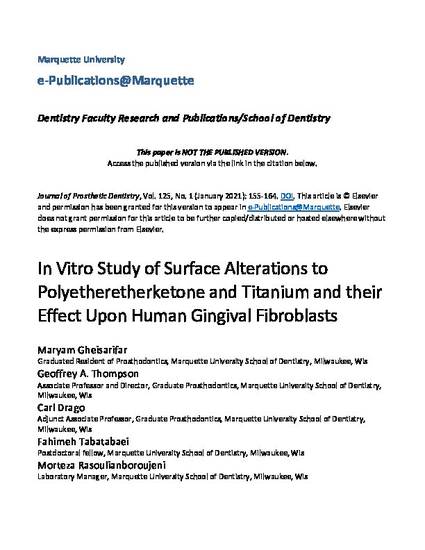
Statement of problem
Soft-tissue attachment to different surfaces may play a pivotal role in the long-term success of dental implants. However, studies on the issue, especially on newer materials, are sparse. Purpose
The purpose of this in vitro study was to evaluate the viability and adhesion of human gingival fibroblasts (HGFs) on different implant abutment materials with specific surface modifications. Material and methods
One hundred and fifty specimens in 6 experimental groups were evaluated: smooth-machined titanium alloy (Ti), laser-modified titanium (TiL), smooth-machined polyetheretherketone (PEEK) (P), laser-modified PEEK (PL), plasma-treated PEEK (PP), laser- and plasma-treated PEEK (PLP). Machined Ti was considered as the control group. Surface roughness (Sa), water contact angle (WCA), and X-ray photoelectron spectroscopy (XPS) were measured. HGF attachment and proliferation were observed at 1, 3, and 7 days after cell seeding. Comparison of the means among the groups was performed with 1-way analysis of variance (ANOVA) with post hoc comparison using the Tukey test (α=.05). Results
Sa values of the laser modified groups were significantly higher than those of the nonmodified (smooth-machined) groups (P<.001). WCAs were significantly different among PEEK groups, and plasma-sprayed groups had the lowest WCAs. XPS analysis of both Ti and PEEK groups showed laser treatment did not have any significant effect on the surface composition of the PEEK as the same bonds with similar ratio/fraction were detected in the spectrum of the modified specimens. Scanning electron microscopy (SEM) revealed more functionally oriented HGF cells on the laser-grooved surfaces. On the first, third, and seventh day of proliferation, the titanium groups showed no significant differences (P>.05). On the first and third days of proliferation, the plasma sprayed groups (PP, PLP) showed significantly greater proliferation than all experimental groups (P<.001). On the seventh day of proliferation, statistically significant differences were observed between all PEEK groups and between all PEEK groups and the Ti group (P<.001), with the exception of the PL and P groups and the PLP and Ti groups (P>.05). Conclusions
Laser-modified titanium and PEEK surfaces led to guided gingival fibroblast attachment. Plasma treatment of PEEK surfaces increased the wettability of this polymer and improved proliferation of HGF.
Available at: http://works.bepress.com/fahimeh-tabatabaei/10/
Accepted version. Journal of Prosthetic Dentistry, Vol. 125, No. 1 (January 2021): 155-164. DOI. © 2021 Elsevier. Used with permission.